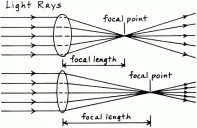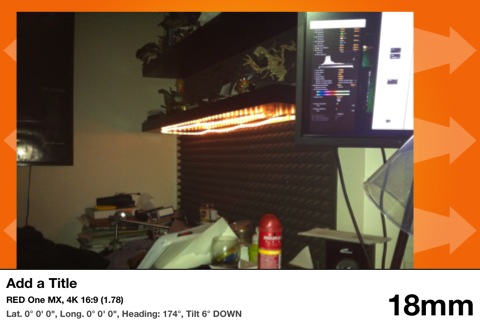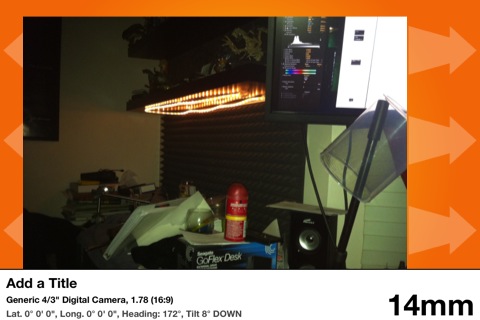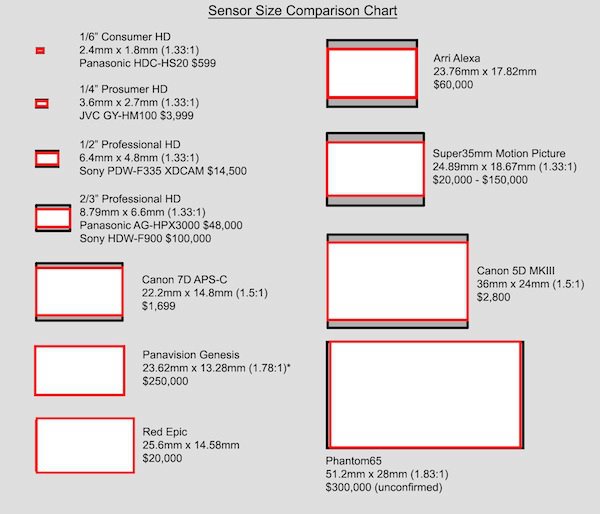
-
@oscillian I've been wondering why this has not happened yet, and can only assume that it must be far more complicated than I am imagining. I assume if it were possible to "shrink" the image circle, that the effective angle of view would widen back out as well, which would be very useful, actually. Worth spending quite a bit of money on, in fact.
-
@oscillian, this is kinda the 35mm adapter principle all over again isn't it? Project an image from the still lens onto the much smaller sensor while preserving the same image characteristics.
-
@Meierhans: No, 50mm is always 50mm. Crop factor is a useful tool, because it lets you standardize focal lengths. Although 50mm looks very different on a 5D than it does on a GH2, if you know the crop factor you can equivalate the two. 50mm focal length * 2x crop factor = 100mm, meaning that a 50mm lens on a GH2 will have roughly the same perspective as a 100mm lens looks on a 5D. Full frame is definitely an arbitrary term for an arbitrary sensor size, but it is useful for those who have a background in 35mm still photography.
-
If you have a phone that will run it, or an iPad, get Artemis Viewfinder, if you go full screen, and snap pictures using different sensors, lens brands, etc... you'll see pretty quickly the difference.
What Sangye is saying is true the 50mm designation is the measurement between the front element of the lens to the focal point where all the rays of light coming through that element converge. On a 50mm lens it is 50mm from front element to the point of convergence.

 DETERMINE_HOW_THE_FOCAL_LENGTH_OF_A_MAGNIFYING_LENS_AFFECTS_ITS_MAGNIFYING_POWER_01.gif438 x 284 - 8K
DETERMINE_HOW_THE_FOCAL_LENGTH_OF_A_MAGNIFYING_LENS_AFFECTS_ITS_MAGNIFYING_POWER_01.gif438 x 284 - 8K -
50mm lens has 50mm focal length. It's the optical characteristic of the lens, and it doesn't change whether you use it on FF, Super35, or M43.
-
but the FOV does change. And for that, shian is wrong to his producer. He will need a 9mm to get an 18mm FOV
-
@christianhubbard face palm No, I won't. A 14mm would be more than sufficient. But 18mm is still plenty wide on a 4/3 sensor.
Both shot with Generic 35mm Cinema lenses one an 18mm on a Red MX, the 2nd a 14mm on the GH2 (or the setting I've used to determine GH2 fov which has been pretty damn accurate. (sorry iPhone not on tripod, but you can still tell I've got approximately the same framing if not a bit wider)



 image.jpg480 x 320 - 47K
image.jpg480 x 320 - 47K
 photo.JPG480 x 320 - 48K
photo.JPG480 x 320 - 48K -
@Shian regarding the relationship between focal length and DOF, I'm afraid you're mistaken. The equation for calculating is as follows:
Depth of Field = [2 * focal length^2 * distance to subject (distance to subject - focal length)] / [(focal length^4 / circle of confusion criterion^2 * f-stop^2) - (distance to subject - focal length)^2]
More here: http://www.naturescapes.net/102004/ps1004.htm
Clearly, depth of field is mathematically dependent on focal length, distance to subject, "circle of confusion criterion", and f-stop.
Here's a chart of the DOFs of a 25mm, 60mm, and 100mm lens all set to f/8: http://www.naturescapes.net/102004/Fig4.gif
All of this should be obvious, though. If you compare how a 200mm f/2.8 lens renders an object and its backdrop to an equivalent crop from a 20mm f/2.8 lens, it's clear that DOF is highly dependent on focal length, well beyond what could possibly be explained by this "optical illusion" that the site you linked references.
After all, the f-stop of a lens is the ratio of the focal length of that lens to the diameter of the entrance pupil. A 200mm f/2.8 lens has a much larger diameter of entrance pupil than that of a 20mm f/2.8 lens. The only thing that a 20mm f/2.8 and 200mm f/2.8 have in common is that they allow a similar amount of light through to the sensor... which is not at all the only factor relevant to establishing DOF.
Edit: more directly on topic, this is why a GH2 with a 25mm f/0.95 Nokton can't touch the DOF of a 5D with a 50mm f/0.95 Noktor, let alone a medium format camera with a 114mm f/0.95 Perkin Elmer, despite all having the same max f-stop and roughly the same field of view. It has nothing to do with the sensor sizes of the cameras, only that to have equivalent fields of view, these cameras need lenses with significantly different focal lengths, which in turn have significantly different DOFs.
-
@Sangye apples and oranges.
When keeping the framing the same (equivalent FOV) there is zero difference in DOF between any lens at any focal length when used at the same aperture. I was trying to bust the myth that I hear nearly everyday. "Just back up, zoom in and reduce the depth of field..."
Beyond that, sigh yes, focal length is a factor. So, if you have any other extraneous facts, please, by all means, add some more confusion to the issue (and thus defeat the purpose of this thread, which was to try and clear up the confusion regarding lenses and crop factor, not create more confusion.)
I guess I'm just going to have to shoot a tutorial over at Panavision and allow the real experts to clearly explain everything, since I don't seem to be making any headway in that department.
-
@Shian I have great respect for your knowledge and your desire to clarify these factors for PV readers, and it certainly is not my intention to add any more confusion to an admittedly confusing issue. That having been said, in my view you are the one that is adding confusion to it at the moment.
To address your statement that "when keeping the framing the same (equivalent FOV) there is zero difference in DOF between any lens at any focal length when used at the same aperture", that simply is not true. See my edited-in note in my last post about the differential DOFs of a GH2 with 25mm f/0.95, 5D with 50mm f/0.95, or MF with 114mm f/0.95. All of these may be set to the same f/0.95 aperture, and will have a roughly equivalent FOV, but they produce dramatically different depths of field. To simplify this further, put all of these lenses on a GH2, and crop the 25 and 50 to match the FOV of the 114mm. This will again produce vastly different depths of field.
Backing up and zooming in does not "keep framing the same", nor does it produce an "equivalent FOV". Zooming in by definition reduces FOV... that's precisely what "zooming" is. Moreover, the distance of the subject has no bearing on FOV; FOV is dependent only on focal length and the dimensions of the sensor (and any cropping that may be done in-camera or in post-production).
If by "equivalent FOV" you mean only that the subject in focus takes up an equivalent area of the image, and you're talking about moving away from the subject to maintain equivalent framing in that regard, then it gets even more complicated, and you certainly can't count on the same aperture producing the same DOF. Looking at that equation I posted above, you'll see that the relationship between the focal length and distance from subject in deriving DOF is more complicated than that. In particular, the relationship of [2 * focal length^2 * distance to subject (distance to subject - focal length)] means that focal length is squared, while distance to subject is multiplied by itself minus the focal length. This basically means that as focal length increases and distance increases (in other words, stepping back and zooming in), the ratio of the numerator to denominator decreases, meaning a narrower DOF. It's subtle, because distance is usually measured in meters while focal length is measured in millimeters, but it is happening.
In any case, all of this presupposes a subject that's at least a few feet from the lens. Another reason that your proposed rule of thumb fails is that DOF equations go haywire with any object closer than a certain distance. Here it gets even more complicated, but Wikipedia covers it somewhat coherently: http://en.wikipedia.org/wiki/Depth_of_field#Close-up . This is relevant, because at a certain point a wide-angle lens very close to a small object will in fact produce a shallower DOF than a telephoto lens further away set to the same f-stop.
TL;DR: depth of field is a highly complicated optical phenomenon. If you don't want to deal with complicated equations, fine -- I personally think just experimenting with lenses and getting a feel for how DOF relates to aperture, focal length, and distance from subject is a much better way of understanding it on a practical level anyway.
-
There is a series of shots on Vimeo from the Portland test of 'medium' priced PL-mount lenses (20K to 40K U$ for a full set!) which shows clearly that visually the DOF is quite constant when you have the same framing. Only the perspective changes (of course). See the portrait in part 2.
BTW, I second that producers with cine experience will always judge FOV referring to 35mm film, not photography. To them you can easily explain that the FOV for the same lens is just a bit narrower on the GH2.
Beware of producers who refer to full-frame photography. They probably don't have a clue about other aspects of cine work either!
-
I stopped worrying about this long ago. I bought a director's viewfinder that had framing for academy 35mm and it matches pretty much perfectly with the Nikon lenses I have when on the GH2. Honestly I'd rather use the M4/3 sensor than a full frame. I used a 5Dmk2 on a shoot a couple weeks ago and while being nice, it was damn hard to focus it wide open, that razor thin DOF was killing me.
-
Another handy little guide, from my friends over at Panavision.


 sensor_compare.jpg600 x 514 - 40K
sensor_compare.jpg600 x 514 - 40K -
LOL, Panavision too busy with dinosaur and $ilverscreen taxonomy to note furry M43 mammals scurrying about?
-
No they're too busy making this - http://www.personal-view.com/talks/discussion/6324/new-panavision-digital-cinema-camera
Howdy, Stranger!
It looks like you're new here. If you want to get involved, click one of these buttons!
Categories
- Topics List23,992
- Blog5,725
- General and News1,354
- Hacks and Patches1,153
- ↳ Top Settings33
- ↳ Beginners256
- ↳ Archives402
- ↳ Hacks News and Development56
- Cameras2,367
- ↳ Panasonic995
- ↳ Canon118
- ↳ Sony156
- ↳ Nikon96
- ↳ Pentax and Samsung70
- ↳ Olympus and Fujifilm101
- ↳ Compacts and Camcorders300
- ↳ Smartphones for video97
- ↳ Pro Video Cameras191
- ↳ BlackMagic and other raw cameras116
- Skill1,960
- ↳ Business and distribution66
- ↳ Preparation, scripts and legal38
- ↳ Art149
- ↳ Import, Convert, Exporting291
- ↳ Editors191
- ↳ Effects and stunts115
- ↳ Color grading197
- ↳ Sound and Music280
- ↳ Lighting96
- ↳ Software and storage tips266
- Gear5,420
- ↳ Filters, Adapters, Matte boxes344
- ↳ Lenses1,582
- ↳ Follow focus and gears93
- ↳ Sound499
- ↳ Lighting gear314
- ↳ Camera movement230
- ↳ Gimbals and copters302
- ↳ Rigs and related stuff273
- ↳ Power solutions83
- ↳ Monitors and viewfinders340
- ↳ Tripods and fluid heads139
- ↳ Storage286
- ↳ Computers and studio gear560
- ↳ VR and 3D248
- Showcase1,859
- Marketplace2,834
- Offtopic1,320














